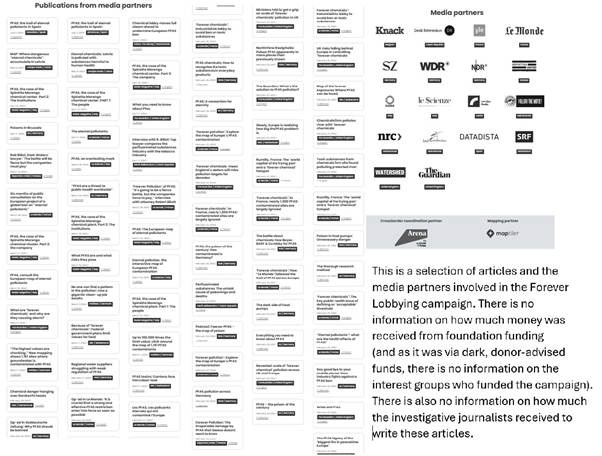Inside the PFAS Forever Chemical Campaign War Room
How Activists Decided TFA Would be Their Next Forever Fear Campaign
Hungarian translation
Imagine a smoky meeting room with no windows in a Brussels incubator shared by a wide variety of NGOs. Six activists banging away on their laptops, three from campaign groups like Friends of the Earth, Corporate Europe Observatory and Pesticide Action Network, two freelance journalists (one French, one Dutch) and, of course, the person with the foundation purse strings, Stéphane Horel. The purpose of the meeting is to plan the next fluorinated substance to spotlight from within the PFAS category of “forever chemicals” and upon which to concentrate their anti-chemical, anti-industry fear campaign energy.

Thousands of chemical products have been derived from fluorine, an abundant natural element with favorable properties meeting the needs of many applications. The war room activists needed to find the right PFAS substance – one that would have the makings of a successful public fear campaign, hold media attention and tap into the foundation funding opportunities.
In front of them was a massive spreadsheet with thousands of fluorinated chemicals so the sorting process needed some effort and a well-defined criteria. They designed a 12-Point Checklist to determine the best new forever chemical fear candidate. The targeted substance had to:
Have a large number of consumer applications;
Be produced by large chemical companies (with litigation opportunities to attract more tort law firm campaign funding via dark foundations);
Have sufficient data on environmental exposure (soil and groundwater);
Be classified as a “forever chemical” (ie, does not easily break down);
Be able to be identified as reprotoxic with a heightened risk for pregnant women and children;
Be a potential carcinogen (or have some campaign-friendly activist scientists who could speculate on that);
Not be in the environment from natural sources and could be replaced by alternatives (ie, precautionable);
Be intentionally released into the environment (and not due to some industrial accident);
Have a frightening name that could be manipulated and easily remembered by the public;
Be easily understood as a bad thing by journalists, foundation fiscal sponsors and influencers;
Have common exposure channels (like drinking water, food…);
Be perceived as all purveying and able to easily be portrayed at a crisis level (eg, detectable in rainwater).
After several hours of triage, the activists’ spreadsheet pointed to TFA (trifluoroacetic acid) as their next PFAS campaign target. It ticked all of the boxes on their checklist: widely detected in water and food, affecting humans and the environment, persistent, comprehensible and frightenable.
But there are innumerable applications for this substance providing a wide range of benefits. TFA is used in refrigerants (but as summer is about to start, not many people would want to give up their air conditioning). Pharmaceuticals and fire-fighting chemicals include TFA so some people might consider it an acceptable risk. More challenging for the activist campaign designers, TFA has been identified as a much more sustainable alternative to other PFAS substances.
The war room strategists pouring over their PFAS spreadsheet needed to focus on one TFA application that would motivate campaigns, create public outrage, generate funding and media interest. More than protecting the environment or public health, the activists in the PFAS war room were searching for that one gold standard TFA application to build a easily winnable campaign.
Somebody then Googled “TFA and pesticides” and the activists intuitively knew then who would be paying their lunch for the next two years.
It’s All About Perception, not Reality
Bringing pesticides into the “forever chemical” campaign would certainly amplify the public fear and outrage, bring in other NGOs, offer wider foundation and litigation funding opportunities and more emotional media coverage. The PAN activist, rubbing his hands in delight, even speculated on campaigning against an entire set of “forever pesticides”. The food industry would certainly not want to be seen to be peddling these chemicals in their products so industry would not be able to speak with a single voice (as if that were ever going to happen). The public would have one more reason to demand the banning of all pesticides and the organic food industry lobby would surely support this campaign with activists and funding.
There are, of course, some minor problems that the activists would have to manage to ensure that their TFA campaign succeeds.
TFA is naturally occurring in the environment and was widely detected before it was used in industrial applications;
it does not bioaccumulate in the body and has a low toxicity;
it is present at extremely low levels in the environment (one part per trillion);
it is often detected as a metabolite (from the breaking down of other substances);
several reputable international bodies have acknowledged that TFA is a negligible risk to human health or ecosystems (see below);
it is not considered a “forever chemical” in the United States (according to the EPA).
This did not deter the activists in the PFAS war room – they have faced these arguments before and expect to be able to brush them off with the usual copy-paste remarks:
It is a man-made chemical that is not supposed to be in the environment or in our bodies;
we just don’t know the risks (add the “chemical cocktail effect” for good measure in case someone calculates the risks);
its exposure levels are increasing, adding to the overall chemical burden in our bodies;
the polluters will need to pay to clean it up (cue support from environmental services companies);
and in any case, we don’t need to use these pesticides.
The activists in the war room, from past experience, feel pretty confident the public and the media would be too lazy to actually look at the facts, reacting rather to the perception of a serious risk, relentlessly amplified through news reports, investigative articles and journal publications. And no one would be so foolish as to stand up and be seen defending the chemical industry. If anyone dared speak out, they would be shouted down and personally attacked as a paid Monsanto shill (even though the much-maligned company has not existed for almost a decade).
This latest “forever chemical” campaign is not about presenting the best scientific facts and arguments. This is not about preventing human health risks. This is not about protecting the environment. This is only about winning a campaign, raising more funding and challenging the right of industry and modern agriculture to exist. And if it is only about winning, then integrity and honesty are easily expendable.
But sometimes the facts do still get in the way.
The BFR, the German Federal Institute for Risk Assessment, looked at the exposure risk from TFA in wine (also, curiously, detected in organic wine) and drew the following conclusion:
The result: based on the highest measured value, a person with a body weight of 60 kilograms (kg) would have to drink at least 9 litres of wine per day to exceed the health based guidance values of 0.05 mg per kg body weight.
The BFR statement could not help but add that the exposure from the ethanol in those nine liters of wine per day would pose a far higher risk.
The UN Environment Programme declares:
Trifluoroacetic acid (TFA) continues to be found in the environment, including in remote regions, although concentrations are so low that they are currently very unlikely to have adverse toxicological consequences for humans and ecosystems.
In the same report, UNEP also suggests that much of the TFA in the environment may be coming from natural sources.
But who listens to scientific facts or evidence when you can run a campaign about “PFAS pesticides pushing planetary boundaries”? And with such claims, how could the media resist simply amplifying the campaign rhetoric? Maybe the media are too lazy to investigate the facts on TFA before publishing an article. Or are they part of Stéphane Horel’s Forever Lobbying media network with access to its research funds and resources?
The Media is the Message
To no surprise, the media is exploding with articles on TFA, pushing skittish European regulators to respond by rushing through restrictive laws with no time for industry to responsibly develop alternatives.
Earlier this year, the Firebreak showed how Stéphane Horel amassed undeclared amounts of funding for her anti-PFAS “Forever Lobbying” campaign. This money came from dark, donor-advised channels within four foundations to support journalists who published PFAS articles. And the articles, mostly based on Horel’s anti-PFAS campaign materials and claims from activist scientists in her network, are starting to come out with high regularity and consistency.

Getting funding from interest groups to produce articles in mainstream news outlets is sadly becoming standard practice in reporting today. Foundations set up organizations to fund journalists (either directly or via media groups, regranting funds or dedicated projects). The Firebreak has shown how Covering Climate Now and the Solutions Journalism Network were created by foundation fiscal sponsors to fund journalists pushing the climate narrative, how foundations are directly funding news organizations like The Guardian with hundreds of millions of dollars or how foundation-funded activist campaigns are then reported by the same foundation-funded journalists. But in some of these cases, the journalists and research groups declared their funding (for those with time to follow the small print). Horel, though, feels such transparency is for stupid people.
These same people who blindly trust Horel are expected to believe the claims coming out of the latest chapter of their well-funded PFAS campaign, their news reports and quotes from their low-level activist scientists.
This is all becoming too predictable. Another PFAS “forever chemical” fear. Another organization created by a collection of foundation fiscal sponsors. Another activist deception campaign. Another failure in science communications. Another case where industry groups could not work together to protect their substances.
… and that activist war room is just getting started.


